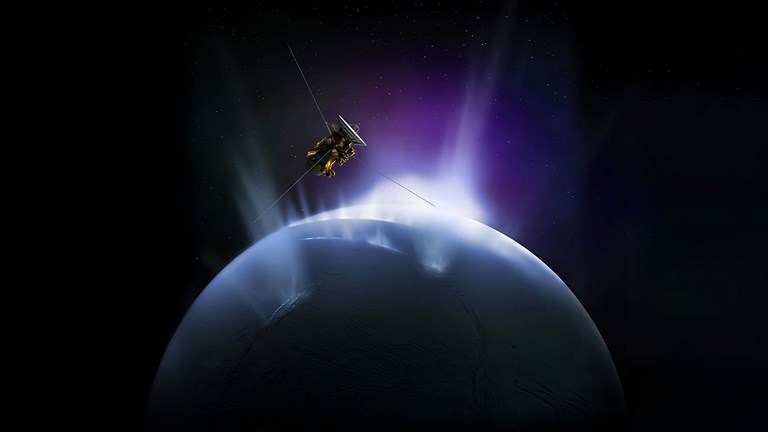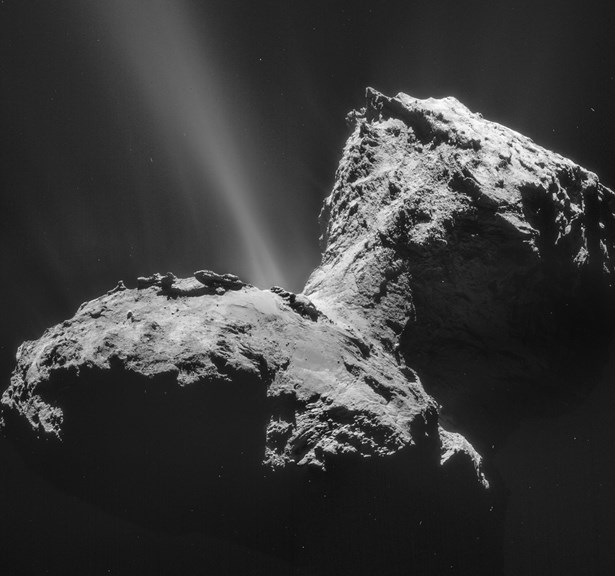Skynotes: November 2023
Upcoming events
Landing on a comet
Almost ten years ago this month, the first landing occurred on the core or nucleus of a comet - the 3.4 km-sized Comet 67P/Churyumov-Gerasimenko. ESA’s little lander Philae detached from the probe Rosetta to attempt a controlled landing. Its harpoons failed to deploy to give it a secure footing. Philae rebounded, bounced and floated in the low gravity before it finally came to rest in a crevice in the surface of the comet. Limited data was received from the lander before it went into hibernation, unable to recharge its batteries since the solar panels were in sunlight for only a short time. Philae has been silent ever since. Rosetta's own extended mission ended two years later on 9 September 2016. It was slowly brought to a gentle impact on the comet sending images up to the last few seconds.
However, detailed images from the parent ship Rosetta overhead revealed the comet to be twin-lobed; two smaller bodies joined by a narrow neck. It saw numerous bright water ice patches on the surface and pits venting material from the subsurface as the comet is heated by the sun. The jets carrying gas and dust particles outward creating a diffuse coma around the nucleus and long tails pointing away from the sun by pressure of the solar wind.
The comet is a low-density porous aggregate of grains, dust and water ice with an angular hard crusty surface. It surface seems darkened by eons of solar exposure. In some particularly dusty areas there are enigmatic dune-like ripples and boulders with trailing tails. Such effects may be caused by a combination of the comet’s rotation, its low gravity, and jets venting sideways along the surface. Inside it may be up to 85% empty space.
Comet 67P orbits the sun every 6.5 years on an elliptical path that takes it from beyond Jupiter to inside Mars. Each time it moves sunward it loses ice and dust. Eventually, it may evolve into an inert rubble pile not unlike some small low-density asteroids in the inner solar system. The comet may have once been two bodies that gently joined, but if cracks in its narrow neck grow it may split apart and become two again.
Explore
Comet 67P/Churyumov-Gerasimenko
Rosetta's Grand Finale Frequently Asked Questions
Melbourne Sun times
| Date | Rise | Set | Day length | Solar noon* |
|---|---|---|---|---|
| Wednesday 1st | 6:13am | 7:54pm | 13:40 hours | 1:03pm |
| Saturday 11th | 6:03am | 8:04pm | 14:01 hours | 1:04pm |
| Tuesday 21st | 5:56am | 8:15pm | 14:19 hours | 1:05pm |
| Thursday 30th | 5:52am | 8:25pm | 14:32 hours | 1:08pm |
*When the sun is at its highest, crossing the meridian or local longitude.
Moon phases
| Phase | Date |
|---|---|
| Third Quarter | Sunday 5th |
| New Moon | Monday 13th |
| First Quarter | Monday 20th |
| Full Moon | Monday 27th |
Moon distances
Tuesday 7th is Lunar apogee (furthest from Earth) at 404,569 km.
Wednesday 22nd is Lunar perigee (closest to Earth) at 369,818 km.
Planets
Mercury
The speedy planet, orbiting closest to the Sun, has passed behind the Sun for solar conjunction but is yet to reappear in our night skies.
Venus
The bright ‘morning star’ can easily be seen in the pre-dawn light from around 4am before fading by sunrise.
Mars
The Red Planet is about to journey behind the Sun for its solar conjunction and is not visible in November.
Jupiter
Having been bright in opposition (on the opposite side of Earth to the Sun), this giant planet continues to be seen in the evenings from 8pm in the north-east. It will move across the north and set in the north-west around 4am.
Saturn
The faint and yellowish ringed planet is visible from 9pm high in the north-west before setting in the west by 2.30am.
Meteors
November has two meteor showers; the Taurids and the Leonids, and in good dark skies up to 10-15 meteors could per hour could be seen.
The Taurids are bright, slow moving with colourful fireballs and occur in the first week of November in Taurus the Bull near the Pleiades star cluster and also near the red star Aldebaran.
The Leonids are high speed meteors that leave trains lasting several minutes. They appear in Leo which rises around 4am in the north-east from 13th - 20th but their peak on the morning of the 18th. They arise from particles left by Comet Tempel-Tuttle as it orbits the Sun every 33 years, but the number of Leonid meteors has been declining over recent years with perhaps only 15 per hour.
Find out more
NASA Leonid News
Deborah Byrd’s Astronomy Essentials EarthSky
ESA About the Leonids.
Stars and constellations
In the north
The constellation of Pegasus, the winged horse is in the north this month with Andromeda low in the north-west. Aquila (the eagle) and its principal star Altair (Alpha Aquilae) is in the north-west.
Low in the north this month is the Andromeda Galaxy, the furthest object visible to the naked eye at 2.5 million light years. This large spiral galaxy contains perhaps 1 trillion stars and takes up an area in the sky larger than the moon. For more enjoy NASA’s Swift Tour of Andromeda Galaxy.
In the west
Spectacular Scorpius is now in the west. The red-giant star Antares (Alpha Scorpii) sits as the middle of three stars that form the arachnid’s body. Sagittarius, the centaur-archer, is above with its bow and arrow forming the well-known Teapot asterism. Further up sits Capricorn, the sea goat, the strange goat with the tail of a fish.
In the east
Orion, the hunter, rises late in the evening this month, one foot being the blue-giant star Rigel (Beta Orionis) and a shoulder the red-giant star Betelguese (Alpha Orionis). The bright stars known as Orion’s Belt are Alnitak, Alnilam and Mintaka (and form the base of the Saucepan asterism), while Orion’s scabbard (the saucepan’s handle) hanging from his belt contains in its centre the beautiful Orion nebula - a vast gas cloud 1300 light years away where stars formation is occurring. Note that Orion appears upside down in the Southern Hemisphere.
Also, upside down is Taurus, the bull, with the red-giant star Antares (Alpha Scorpii), rising in the north-east later in the night. In the south-east past Orion is Canis Major, greater dog, and its star Sirius (Alpha Canis Majoris), the brightest star visible at night and also referred to as The Dog Star.
Approaching summer, the night sky from north-east to south-east will include a diverse range of features to enjoy.
In the south
Low in the south this month is Crux (Southern Cross) with the two Pointers, Alpha and Beta Centauri, to its right in the constellation Centaurus. In the south-east shines the second brightest star at night Canopus (Alpha Carinae), the principal star for the constellation Carina, the Keel.
The broad band of the Milky Way arcs from south-east along the western horizon to north-west. During the night as the Earth rotates to the east it will ‘wheel’ across the sky so that by 3am it will stretch from west to east.
International Space Station
ISS orbits every 90 minutes at an average distance of 400 km appearing like a bright star moving slowly across the night sky. Here are some of the brightest passes expected this month over Melbourne and Central Victoria.
Morning
Friday 24th 4:38am to 4:43am. North-West to South-East
Monday 27th 3:48am to 3:51am. West-North-West to South-East
Evening
Only two visible passes occur in the evening this month (on 1st & 2nd) but neither of them are bright.
Heavens Above gives predictions for visible passes of space stations and major satellites, live sky views and 3D visualisations. Be sure to first enter your location under ‘Configuration’.
On this day
1st 1963, then largest radio telescope, the Puerto Rico Arecibo Observatory, opens utilising a natural valley and transceiver suspended from pylons on nearby peaks.
3nd 1957, Laika, a 3-year husky-Samoyd dog, became the first animal into orbit in Sputnik 2 (USSR). While never intended to return to Earth, she expired from heat stress after only a few hours.
3rd 1973, Mariner 10 (USA) launches to Mercury, the first probe to use a gravitational ‘slingshot’ around a planet to reach an objective (in this case, Venus).
4th 2003, largest solar flare recorded causes radio blackouts and saturates satellites, and was associated with a Coronal Mass Ejection (CME) many times larger than Earth leaving the Sun at 2,300 kph.
8th 1656, birth of second Astronomer Royal Edmund Halley who calculated several historical comets to be the same. He successfully predicted its regular 76-year return. It posthumously carries his name.
9th 1934, birth of American astrophysicist and science communicator Carl Sagan.
12th 2014, First landing on a comet and direct surface images of Comet Churyumov-Gerasimenko by Philae lander from ESA’s Rosetta probe.
12th 1980, Voyager 1 (USA) has historic close encounter with Saturn at 124,000km. It then flew by moon Titan which precluded going on to Uranus or Neptune, although both were later visited by Voyager 2.
13th 1971, Mariner 9 (USA) is the first spacecraft to orbit another planet, Mars. Months of a planet-wide dust storm finally cleared to allow pictures of the surface.
15th 1738, discoverer of Uranus and infrared radiation, William Herschel, is born.
14th 2003, Sedna, a TNO (Trans Neptunian Object) is discovered in a 11,400 year elongated orbit, one of the most distant objects known in the Solar System.
16th 1965, Venera 3 (USSR) is launched to Venus becoming the first probe to reach the surface of another world.
16th 1974, first radio message sent into space (USA/Puerto Rico). ‘Arecibo Message’ to star cluster M13 25,000 light years away took 3 min. Its 1,679 binary 1’s and 0’s if arranged in 23 columns and 73 rows will reveal visual information (prime numbers 23 x 73 = 1,679).
17th 1970, Lunokhod 1 (‘Moon Walker’, USSR) first remote-controlled moon rover. Delivered by lander Luna 17, it drove 10km and lasted 321 Earth days, far longer than the expected 3 months.
20th 1998, First module for the ISS, Russia’s 12 metre Zaryu (‘Sunrise’) or Functional Cargo Block, is launched beginning a multi-module multi-year assembly of the space station in low Earth orbit.
26th 2012, Curiosity rover (USA) arrives in Mars’ Gale Crater after a high-speed entry and first use of an innovative final landing technique – the ‘sky crane’.
27th 1971, first probe to reach the Martian surface is Mars 2 (USSR) although it crashes in the process.
27th 2001, first detection of composition of exoplanet’s atmosphere – by Hubble Telescope for planet Osiris orbiting a sun-like star 150 light years away.
28th 1967, Cambridge postgraduate student Susan Jocelyn Bell discovers the first pulsar, dubbed LGM1 for “little green men”. Its regular 1.3 sec radio pulse revealed it to be a rapidly spinning neutron star – the first of many to be identified.
29th 1967, Australia becomes the third nation after USSR, USA and France to launch a satellite from its own territory. The 45kg WRESAT-1 (Weapons Research Establishment Satellite) made 642 polar orbits until re-entry 11 days later.
30th 1609, Galileo studies the Moon with his improved telescope, and while not the first to do so he was the first to explain mountains and craters, and chart lunar features and their heights.
30th 1954, Ann Elizabeth Hodges of Alabama, USA, becomes the first person injured by a meteorite. She was badly bruised by a 5kg rock that crashed through her roof, deflected off a radio cabinet, and hit her while she was asleep on the couch.




